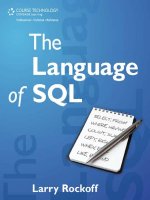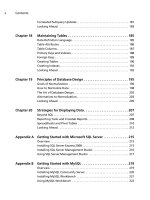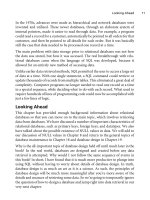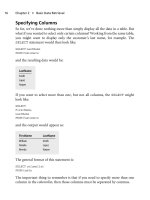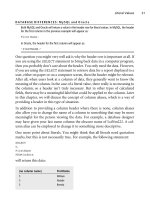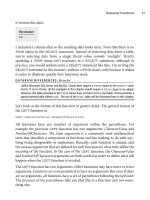The Language of SQL- P18 pptx
Bạn đang xem bản rút gọn của tài liệu. Xem và tải ngay bản đầy đủ của tài liệu tại đây (115.48 KB, 5 trang )
chapter 8
Boolean Logic
Keywords Introduced: AND, OR,
NOT, BETWEEN, IN, IS, NULL
In the previous chapter, we introduced the concept of selection criteria, but only in
its simplest form. We’re now going to expand on that concept to greatly enhance
our ability to specify the rows that are returned from a
SELECT.Thisiswhere
the pure logic of SQL comes into play. In this chapter, we are going to introduce
a number of operators that will allow you to create complex logical expressions.
With these new capabilities, if a user comes to you and says that she wants a list
of all female customers who live in ZIP codes 60601 through 62999, but excluding
anyone who’s under the age of 30 or who doesn’t have an email address, that will
be something you can provide.
Complex Logical Conditions
The WHERE clause introduced in the previous chapter utilized only simple
selection crit eria. You saw
WHERE clauses such as:
WHERE QuantityPurchased ¼ 5
The condition expressed in this WHERE clause is quite simple: It returns all rows
where the Quan tityPurchased column has a value of 5.
In the real world, the selection of data is often far from straightforward.
Accordingly, let’s now turn our attention to ways of specifying some more
complex logical conditions in your selection criteria.
71
The ability to devise complex l ogical conditions is some time s called Boolean logic.
This term, taken from mathematics, refe rs to the ability to formulate complex
conditions that are evaluated as e ither true or false. In the aforementioned ex ample,
the condition QuantityPurchased ¼ 5 is evaluated as either true or false for each
row in the table . Obviously, you only want to see rows where the condition is
evaluated as true.
The principle keywords used to create complex Boolean logic are
AND, OR,and
NOT. These three operators are used to add additional functionality to the WHERE
clause. In the proper combination, the AND, OR,andNOT operators, along with
parentheses, can specify just about any logical expression you can imagine.
The AND Operator
The following examples will all be taken from this Orders table:
OrderID CustomerName State QuantityPur chased PricePerItem
1 William Smith IL 4 2.50
2 Natalie Lopez CA 10 1.25
3 Brenda Harper NY 5 4.00
Here’s an example of a WHERE clause that uses the AND operator:
SELECT
CustomerName,
QuantityPurchased
FROM Orders
WHERE QuantityPurchased > 3
AND QuantityPurchased < 7
The AND clause means that all conditions must evaluate to true for the row to be
selected.
This
SELECT specifies that the only rows to be retrieved are those where the
QuantityPurchased is both greater than 3 and less than 7. Therefore, only these
two rows are returned:
CustomerName QuantityPurchased
William Smith 4
Brenda Harper 5
Chapter 8
■
Boolean Logic72
Notice that the row for Natalie Lopez is not returned. Why? Natalie purchased a
quantity of 10, which, in fact, does satisfy the first condition (QuantityPurchased
> 3). However, the second condition (QuantityPurchased < 7) is not satisfied
and therefore is not true. When using the
AND operator, all conditions specified
must be true.
The OR Operator
Let’s now look at the OR operator. The AND clause meant that all conditions
must evaluate to true for the row to be selected. The
OR clause means that the
row will be selected if any of the conditions is determined to be true.
Here’s an example, taken from the same table:
SELECT
CustomerName,
QuantityPurchased,
PricePerItem
FROM Orders
WHERE QuantityPurchased > 8
OR PricePerItem > 3
The SELECT returns this data:
CustomerName QuantityPurchased PricePerItem
Natalie Lopez 10 1.25
Brenda Harper 5 4.00
Why are the rows for Natalie Lopez and Brenda Harper displayed, and not the
row for William Smith? The row for Natalie Lopez is selected because it meets the
requirements of the first condition (QuantityPurchased > 8). It doesn’t matter
that the second condition (PricePerItem > 3) isn’t true, because only one con-
dition needs to be true for an
OR condition.
Likewise, the row for Brenda Harper is selected because the second condition
(PricePerItem > 3) is true for that row. The row for William Smith isn’t selected
because it doesn’t satisfy either of the two conditions.
Using Parentheses
Let’s say that you are only interested in orders from customers from either the
state of Illinois or the state of California. Additiona lly, you only want to see
Using Parentheses 73
orders where the quantity purchased is greater than 8. To satisfy this request, you
put together this
SELECT statement:
SELECT
CustomerName,
State,
QuantityPurchased
FROM Orders
WHERE State ¼ 'IL'
OR State ¼ 'CA'
AND QuantityPurchased > 8
When you execute this, you are expecting to get back only one row, for Natalie
Lopez. This is because you have two rows for customers in Illinois or California
(Smith and Lopez). But only one of those (Lopez) has a quantity purchased
greater than 8.
However, when you execute this statement, you see:
CustomerName State QuantityPurchased
William Smith IL 4
Natalie Lopez CA 10
What went wrong? Why did you get back two rows instead of one? The answer
lies with how SQL interprets the
WHERE clause, which contains both AND and OR
operators. Like other computer languages, SQL has a predet ermined order of
evaluation, which specifies the order in which various operators are interpreted.
Unless told otherwise, SQL always processes the
AND operator before the OR
operator. So, in the previous statement, it first looks at the AND and evaluates
the condition:
State ¼ 'CA'
AND QuantityPurchased > 8
The row that satisfies that condition is for Natalie Lopez. It then evaluates the OR
operator, which allows for rows where the State equals IL. That adds in the row
for William Smith. Therefore, it determines that both the William Smith and the
Natalie Lopez rows meet the condition.
Obviously, this isn’t what was meant. This type of problem often comes up when
AND and OR operators are combined in a single WHERE clause. The way to resolve
Chapter 8
■
Boolean Logic74
the ambiguity is to use parentheses to specify the exact order of evaluation that
you would like. Anything in parentheses is always evaluated first.
Here’s how parentheses can be added to the previous
SELECT to correct the
situation:
SELECT
CustomerName,
State,
QuantityPurchased
FROM Orders
WHERE (State ¼ 'IL'
OR State ¼ 'CA')
AND QuantityPurchased > 8
When this is executed, you now see this data:
CustomerName State QuantityPurchased
Natalie Lopez CA 10
The parentheses in the SELECT statement force the OR expression (State ¼ ‘IL’
OR State ¼ ‘CA’) to be evaluated first. This produces the intended result.
Multiple Sets of Parentheses
Let’s say that you want to select two different sets of rows from the Orders table:
first, rows for customers in New York, and second, rows for customers in Illinois
who have made a purchase with a quantity between 3 and 10. The following
SELECT accomplishes this requirement:
SELECT
CustomerName,
State,
QuantityPurchased
FROM Orders
WHERE State ¼ 'NY'
OR (State ¼ 'IL'
AND (QuantityPurchased >= 3
AND QuantityPurchased <= 10))
Multiple Sets of Parentheses 75
